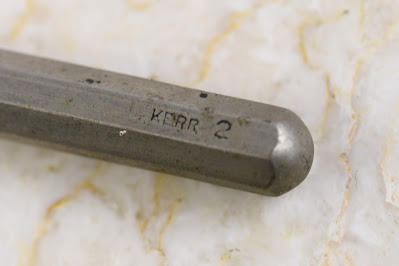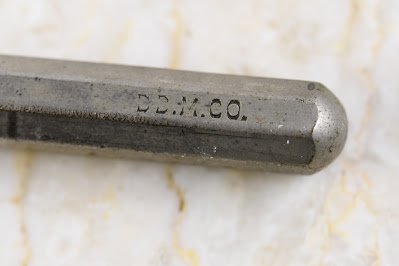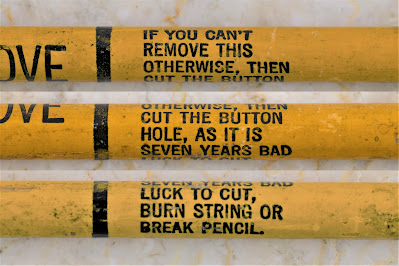This article has been included in The Leadhead's Pencil Blog Volume 7, now available here.
If you don't want the book but you enjoy the article, please consider supporting the Blog project here.
The variety of the pencils I write about is so wide that there are times things slip in because they look like pencils when they really are not. A good example was Birch’s watch key (Volume 3, page 154), which looked enough like a pencil that examples wormed their way into Joe Nemecek’s collection and mine before either of us realized they weren’t supposed to be here.
Here are a couple other objects that have had me scratching my head:
The top one is a gold colored, cylindrical and had a patent date on it that isn’t in American Writing Instrument Patents 1799-1910 – so of course I had to bid on it. When it arrived, though, I suspected something might be amiss:
Although it operates like a leadholder, with a piece that screws down over jaws and crimps them together to hold something, the “something” this was designed to hold is very thin and flat – unless someone in the Nineteenth century was offering really skinny broad italic leads, I suspected this might not be a pencil.
Ah, the good old days of patent searching, before the book came out . . . when all I had was a patent date and no alternative but to plow through the hundreds of patents issued on that date without knowing what I was looking for . . . the date in question was February 1, 1881, and there were 275 patent issued on that date:
It was the perfect way to spend yet another pandemic evening, mindlessly looking at patent after patent, until this one finally surfaced: John H. Crowell of Providence, Rhode Island received patent 237,093 for a magazine toothpick, with replaceable picks made of “quill, whalebone or other elastic material” carved in the shapes of little flat footballs. It’s even a “magazine” toothpick, with a place inside the barrel to store spare picks.
Cool. But definitely not a pencil. If it had pearl slabs like that great double-ended toothpick with Ephraim Johnson’s “pearl patent” on it like the one I posted a few weeks ago (see page ), that would be one thing. Since I’m not launching on a binge collecting things that pick funk from between Victorian teeth though, I’m not really sure what to make of this one.
The grey metal thing looks like a pencil, but if it is, it appears to have exactly zero moving parts: there’s a hole in the front about the size of a standard 1.1mm lead, but it is one solid piece of metal. Maybe it’s a stylus or something with a replaceable stylus? If so, I probed around and there’s doesn’t seem to be anything in there to latch onto anything. On one side near the end, “Kerr 2" is stamped:
On the other, what looks like “D.D.M. Co.” – although it could be “D.B.M.”:
Until I have a better explanation, the Kerr/DDM is a solid “maybe” for inclusion in my pencil collection.
This last one is definitely a pencil, but the “mechanical” part doesn’t relate to how the lead is propelled:
There’s a weird metal cap that looks like the end of a bullet pencil at one end, but with a loop of string attached. In addition to the advertisement for Indianapolis stoves, this pencil includes an odd admonishment:
“If you can’t remove this otherwise, then cut the button hole, as it is seven years bad luck to cut, burn string or break pencil.” There’s a glimmer of hope at the top, just under that metal cap:
“Magic Holetite / U.S. Pat. Off. 343067.” Could this tell me what this is and how it works? No, but at least it tells me who was behind it – that this isn’t a patent number, but a reference to the patent office, where trademarks are also filed. “Magic Holetite” is included in American Writing Instrument Trademarks 1870-1953:
The mark was registered by James J. Sanders of the Sanders Manufacturing Company, 124 Fourth Avenue South in Nashville, Tennessee. Sanders claimed to have first used the mark on both wood cased and mechanical pencils on August 7, 1936.
Sanders filed other marks on behalf of the company, for “Colofour,” “Hexagraph,” and “Promotion.” Sanders Manufacturing Company was a game and novelty maker in Nashville for decades: they were hiring as late as 1995, and I found references to the company’s “PoW-WoW” game in 1924 - “the game that makes them all laugh”:
Like this goofy pencil.












The gray metal thing is a punch - perhaps a leather punch. You hit the rounded end with a hammer.
ReplyDeleteThanks for that - but backchannel, I think Richard Keith came up with the right answer. It's the handle for a dental tool (the tool has gone missing) - writes Richard: "The tool inventor was Robert M. Kerr who assigned it to the Detroit Dental Manufacturing Company (D.D.M. Co.)."
ReplyDeleteMagic Holetite is a magic trick/prank where the pencil is passed through the button hole of the victim and the string loop is passed over the end of the pencil and the entire thing is pulled tight , securing it to
ReplyDeleteThe shirt or coat.
The problem is that the loop is too short to pass over the pencil so it seems impossible to remove. It isn’t but I have no idea of the solution.